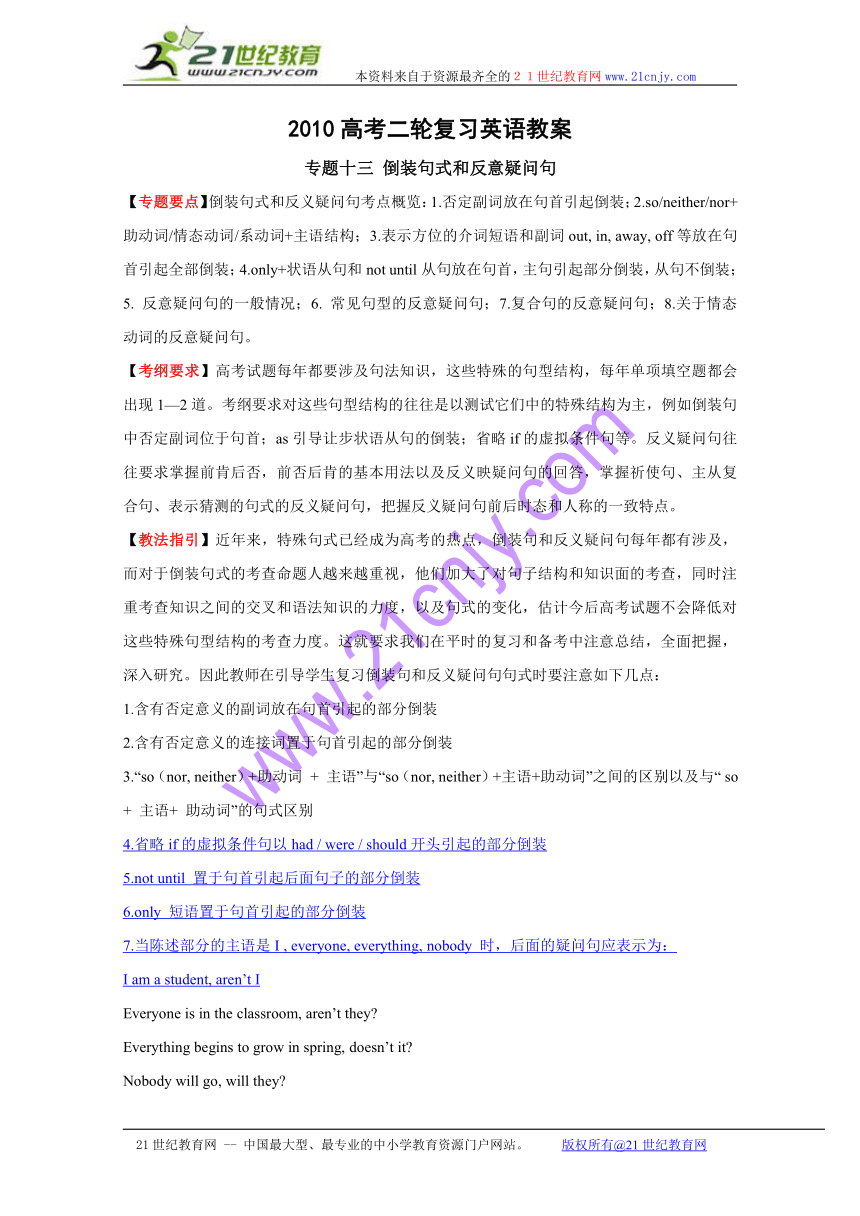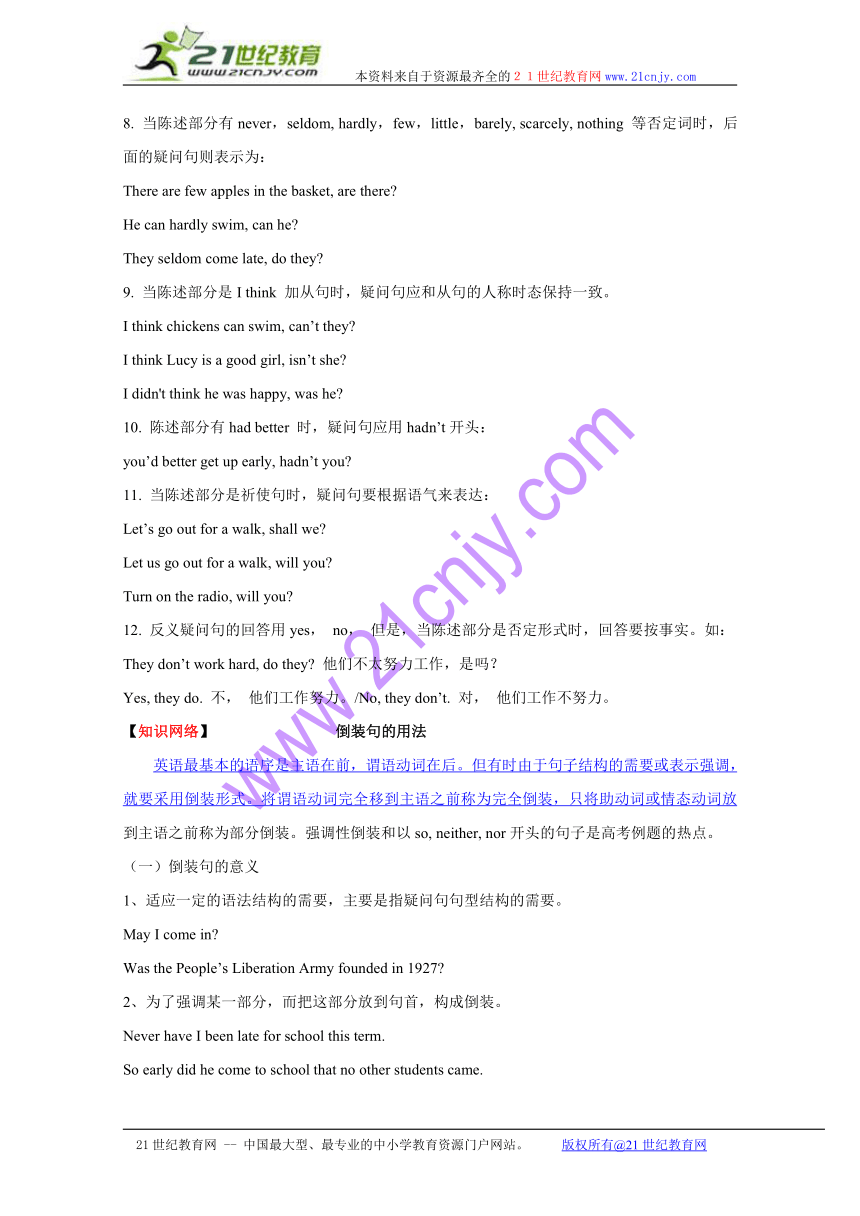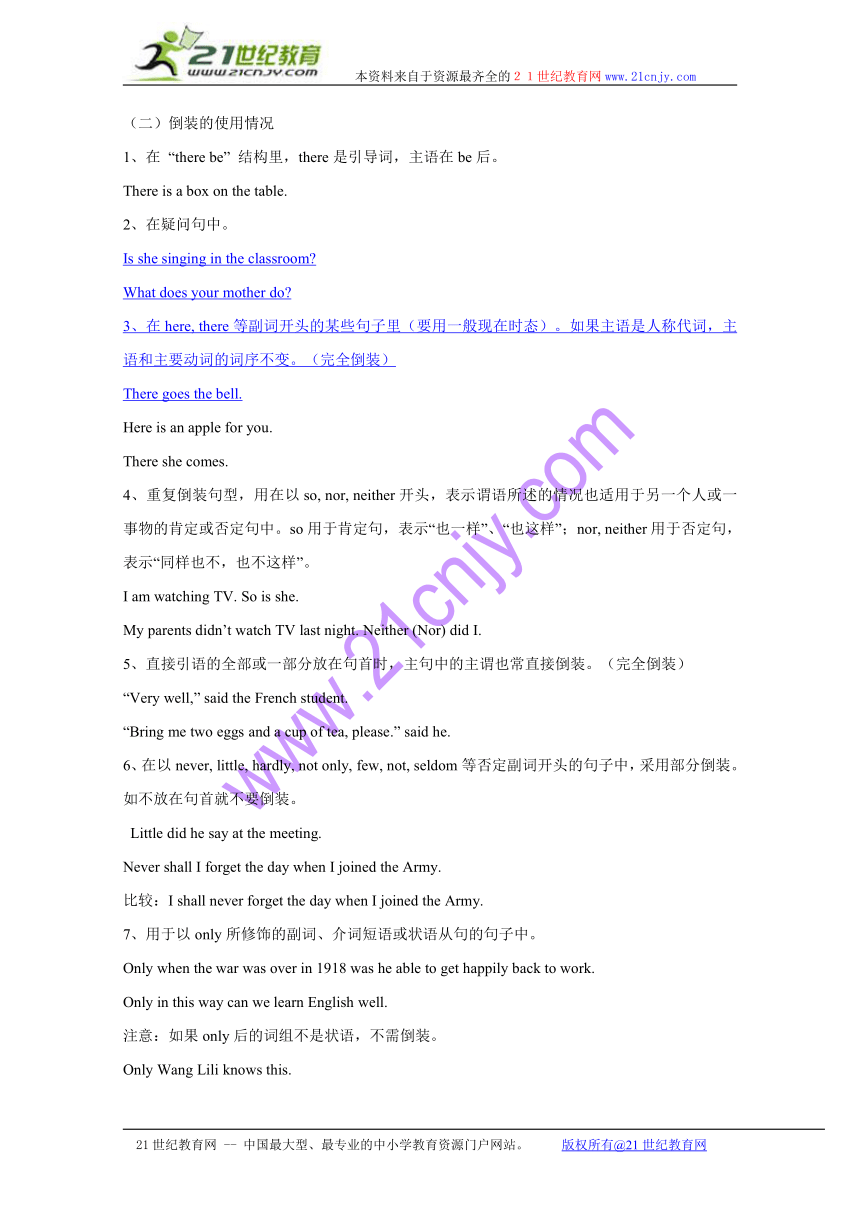2010高考二轮复习英语教案 专题十三 倒装句式和反意疑问句
文档属性
| 名称 | 2010高考二轮复习英语教案 专题十三 倒装句式和反意疑问句 |  | |
| 格式 | rar | ||
| 文件大小 | 17.0KB | ||
| 资源类型 | 教案 | ||
| 版本资源 | 通用版 | ||
| 科目 | 英语 | ||
| 更新时间 | 2009-11-06 19:38:00 | ||
图片预览



文档简介
本资料来自于资源最齐全的21世纪教育网www.21cnjy.com
2010高考二轮复习英语教案
专题十三 倒装句式和反意疑问句
【专题要点】倒装句式和反义疑问句考点概览:1.否定副词放在句首引起倒装;2.so/neither/nor+助动词/情态动词/系动词+主语结构;3.表示方位的介词短语和副词out, in, away, off等放在句首引起全部倒装;4.only+状语从句和not until从句放在句首,主句引起部分倒装,从句不倒装;5. 反意疑问句的一般情况;6. 常见句型的反意疑问句;7.复合句的反意疑问句;8.关于情态动词的反意疑问句。
【考纲要求】高考试题每年都要涉及句法知识,这些特殊的句型结构,每年单项填空题都会出现1—2道。考纲要求对这些句型结构的往往是以测试它们中的特殊结构为主,例如倒装句中否定副词位于句首;as引导让步状语从句的倒装;省略if的虚拟条件句等。反义疑问句往往要求掌握前肯后否,前否后肯的基本用法以及反义映疑问句的回答,掌握祈使句、主从复合句、表示猜测的句式的反义疑问句,把握反义疑问句前后时态和人称的一致特点。
【教法指引】近年来,特殊句式已经成为高考的热点,倒装句和反义疑问句每年都有涉及,而对于倒装句式的考查命题人越来越重视,他们加大了对句子结构和知识面的考查,同时注重考查知识之间的交叉和语法知识的力度,以及句式的变化,估计今后高考试题不会降低对这些特殊句型结构的考查力度。这就要求我们在平时的复习和备考中注意总结,全面把握,深入研究。因此教师在引导学生复习倒装句和反义疑问句句式时要注意如下几点:
1.含有否定意义的副词放在句首引起的部分倒装
2.含有否定意义的连接词置于句首引起的部分倒装
3.“so(nor, neither)+助动词 + 主语”与“so(nor, neither)+主语+助动词”之间的区别以及与“ so + 主语+ 助动词”的句式区别
4.省略if的虚拟条件句以had / were / should开头引起的部分倒装5.not until 置于句首引起后面句子的部分倒装6.only 短语置于句首引起的部分倒装7.当陈述部分的主语是I , everyone, everything, nobody 时,后面的疑问句应表示为:
I am a student, aren’t I ( http: / / www.21cnjy.com / )
5.not until 置于句首引起后面句子的部分倒装
6.only 短语置于句首引起的部分倒装
7.当陈述部分的主语是I , everyone, everything, nobody 时,后面的疑问句应表示为:
I am a student, aren’t I
Everyone is in the classroom, aren’t they
Everything begins to grow in spring, doesn’t it
Nobody will go, will they
8. 当陈述部分有never,seldom, hardly,few,little,barely, scarcely, nothing 等否定词时,后面的疑问句则表示为:
There are few apples in the basket, are there
He can hardly swim, can he
They seldom come late, do they
9. 当陈述部分是I think 加从句时,疑问句应和从句的人称时态保持一致。
I think chickens can swim, can’t they
I think Lucy is a good girl, isn’t she
I didn't think he was happy, was he
10. 陈述部分有had better 时,疑问句应用hadn’t开头:
you’d better get up early, hadn’t you
11. 当陈述部分是祈使句时,疑问句要根据语气来表达:
Let’s go out for a walk, shall we
Let us go out for a walk, will you
Turn on the radio, will you
12. 反义疑问句的回答用yes, no, 但是,当陈述部分是否定形式时,回答要按事实。如:
They don’t work hard, do they 他们不太努力工作,是吗?
Yes, they do. 不, 他们工作努力。/No, they don’t. 对, 他们工作不努力。
【知识网络】 倒装句的用法
英语最基本的语序是主语在前,谓语动词在后。但有时由于句子结构的需要或表示强调,就要采用倒装形式。将谓语动词完全移到主语之前称为完全倒装,只将助动词或情态动词放 ( http: / / www.21cnjy.com / )到主语之前称为部分倒装。强调性倒装和以so, neither, nor开头的句子是高考例题的热点。
(一)倒装句的意义
1、适应一定的语法结构的需要,主要是指疑问句句型结构的需要。
May I come in
Was the People’s Liberation Army founded in 1927
2、为了强调某一部分,而把这部分放到句首,构成倒装。
Never have I been late for school this term.
So early did he come to school that no other students came.
(二)倒装的使用情况
1、在 “there be” 结构里,there是引导词,主语在be后。
There is a box on the table.
2、在疑问句中。
Is she singing in the classroom
What does your mother do
3、在here, there等副词开头的某些句子里(要用一般现在时态)。如果主语是人称代词,主语和主要动词的词序不变。(完全倒装)
There goes the bell. ( http: / / www.21cnjy.com / )
Here is an apple for you.
There she comes.
4、重复倒装句型,用在以so, nor, neither开头,表示谓语所述的情况也适用于另一个人或一事物的肯定或否定句中。so用于肯定句,表示“也一样”、“也这样”;nor, neither用于否定句,表示“同样也不,也不这样”。
I am watching TV. So is she.
My parents didn’t watch TV last night. Neither (Nor) did I.
5、直接引语的全部或一部分放在句首时,主句中的主谓也常直接倒装。(完全倒装)
“Very well,” said the French student.
“Bring me two eggs and a cup of tea, please.” said he.
6、在以never, little, hardly, not only, few, not, seldom等否定副词开头的句子中,采用部分倒装。如不放在句首就不要倒装。
Little did he say at the meeting.
Never shall I forget the day when I joined the Army.
比较:I shall never forget the day when I joined the Army.
7、用于以only所修饰的副词、介词短语或状语从句的句子中。
Only when the war was over in 1918 was he able to get happily back to work.
Only in this way can we learn English well.
注意:如果only后的词组不是状语,不需倒装。
Only Wang Lili knows this.
8、为了表达生动,有时把表地点、方位的副词,如 up, down, out, away, in等放在句首,同时把谓语动词放在主语之前。若主语为人称代词,主语和谓语动词的位置不变,只将副词放在句首。(完全倒装)
Away hurried the boy.
Out rushed the girl.
9、在虚拟结构中,条件从句的谓语含有were, had 和should这三个词是,可省去if,将这些词移至主语之前。
Had I time (= If I had time), I would go and help you.
Were I you (= If I were you), I would go abroad.
Should he come (=If he should come), tell him to ring me up.
10、as引导让步状语从句时要倒装(形容词/ 副词/ 名词/ 动词 + as + 主语 + 谓语)。
e.g. Proud as they are, they are afraid to see me.
Child as he is, he seems to know everything.(child前不加冠词)
Hard as he worded, he made little progress.
11、用于某些表示祝愿的句子里。
May you succeed!
Long live the People’s Republic of China!
12、So + 形容词、副词及such 置于句首时要倒装。
So happy did he feel.
Such was me.
反义疑问句的用法
反义疑问句(The Disjunctive Question)又叫附加疑问句。它表示提问人的看法,没有把握,需要对方证实。反义疑问句由两部分组成:前一部分是一个陈述句,后一部分是一个简短的疑问句,两部分的人称时态应保持一致。
1.陈述部分肯定式+疑问部分否定式
2.陈述部分否定式+疑问部分肯定式
They work hare, don’t they
She was ill yesterday, wasn’t she
You didn’t go, did you
He can’t ride a bike, can he ( http: / / www.21cnjy.com / )
一、反意疑问句的一般情况
1.当陈述部分的主语是:等everyone, everybody, someone, no one, nobody, somebody合成代词时,附加疑问句的主语非正式文体中往往they用。(也可以按语法一致原则用单数。)
2.当陈述部分以one不定代词做主语时,附加问句的主语在正式常场用one,非正式场合用he。
3.当陈述部分的主语是不定式、动名词、从句、this或that,附加疑问句的主语用it。(是those, these则用they)
4.当陈述部分的主语是表示物的不定代词everything, anything, nothing等,附加问句的主语用 it。
5.陈述部分带有否定词或半否定词,例如:never, hardly, scarcely, seldom, no, none, no one, rarely, nowhere, nothing, nobody, few, little等,附加疑问句的动词要用肯定形式。
6.如果陈述部分中的否定词仅带有否定的前缀或后缀,那么该陈述句应作肯定句处理,附加 ( http: / / www.21cnjy.com / )疑问句应用否定形式。
二、常见句型的反意疑问句
7.当陈述部分是there be 存在句型时,附加疑问句的主语也用there。
8.感叹句的附加疑问句,其谓语要求用否定句。
9.祈使句后面的附加疑问句问题
A) 祈使句是否定形式,附加疑问句只能用will you。
B) 祈使句是肯定形式,附加疑问句用肯定、否定均可。
C) Let开头的祈使句要注意:
1.Let’s 在意义上包含谈话的对方在内,表示提出建议或征求对方意见,其反意疑问句往往用shall we。
2. Let us 在意义上一般不包含谈话的对方在内,表示请求对方允许做某事的含义,let 有allow的意思。附加疑问部分用will you。
3. Let me 开头表示请求,附加疑问句用will you,或用may I。
三、复合句的反意疑问句
10.当陈述部分是一个(带that引导宾语从句的)主从复合句时,附加疑问句的主谓要和主句的主谓保持对应关系。但是,当陈述部分的主语是:I suppose, I think, I believe, I imagine, I expect等结构时,附加疑问句的主语和谓语要和从句的主语,谓语保持一致关系。而且要注意到否定的转移问题。
11.当陈述部分是I’m sure that,;we are sure;I’m afraid that;We are sure that;I feel sure that 等后面跟宾语从句时,反意疑问句与后面的宾语从句一致。
12.当陈述部分是并列句时,附加疑问句的主谓语要和离它最近的句子的主谓保持对应关系。
四、关于情态动词的反意疑问句
13.陈述部分中有have一词,且表示“所有”含义时,附加疑问句部分既可用have也可用do。
14.陈述部分中有have to,附加疑问句部分用do。
15.含有ought to 的反意疑问句,陈述部分是肯定的,疑问部分用shouldn't / oughtn't +主语。
He ought to know what to do, oughtn't he / shouldn't he
16.陈述部分有used to,附加疑问句部分可用used 也可以用did 。
17.陈述部分有needn’t时,附加疑问句部分用need但有时也可用must。
18.陈述部分有must,且表示“必须”时,附加疑问句部分用mustn’t,如果表示“必要”则用needn’t。
19.陈述部分中是mustn’t表示“禁止”时,附加疑问句部分用must。
陈述部分中的must表示“一定”、“想必”等推测意义时,附加疑问句部分而是根据陈述部分的谓语动词或其助动词来定。
20.陈述部分是I wish, 表示询问或征求意见,附加疑问部分用may I。
21.弄清陈述句中的’d rather = would rather;’d better = had better附加疑问句部分前者用would,后者用had。
其它特殊结构的反意疑问句
22.陈述部分的主语是each of...结构时,附加疑问句在强调整体时用they,当作个别时用he。
23.陈述部分有neither...nor...(either...or...)做并列主语,附加疑问部分根据其实际逻辑意义而定。
Neither you nor I am engineer, are we
24.陈述部分是:I’m ....结构,附加疑问句一般用aren’t I
25. 陈述部分有had better + v. 疑问句部分用hadn't you
You'd better read it by yourself, hadn't you
26. 陈述部分有would rather +v.,疑问部分多用 wouldn't +主语。
He would rather read it ten times than recite it, wouldn't he
27. 陈述部分有You'd like to +v. 疑问部分用wouldn't +主语。 ( http: / / www.21cnjy.com / )
You'd like to go with me, wouldn't you
28. 带情态动词dare或need的反意疑问句,疑问部分常用 need (dare ) +主语。
We need not do it again, need we
He dare not say so, dare you
当dare, need 为实义动词时,疑问部分用助动词do +主语。
She doesn't dare to go home alone, does she
21世纪教育网 -- 中国最大型、最专业的中小学教育资源门户网站。 版权所有@21世纪教育网
2010高考二轮复习英语教案
专题十三 倒装句式和反意疑问句
【专题要点】倒装句式和反义疑问句考点概览:1.否定副词放在句首引起倒装;2.so/neither/nor+助动词/情态动词/系动词+主语结构;3.表示方位的介词短语和副词out, in, away, off等放在句首引起全部倒装;4.only+状语从句和not until从句放在句首,主句引起部分倒装,从句不倒装;5. 反意疑问句的一般情况;6. 常见句型的反意疑问句;7.复合句的反意疑问句;8.关于情态动词的反意疑问句。
【考纲要求】高考试题每年都要涉及句法知识,这些特殊的句型结构,每年单项填空题都会出现1—2道。考纲要求对这些句型结构的往往是以测试它们中的特殊结构为主,例如倒装句中否定副词位于句首;as引导让步状语从句的倒装;省略if的虚拟条件句等。反义疑问句往往要求掌握前肯后否,前否后肯的基本用法以及反义映疑问句的回答,掌握祈使句、主从复合句、表示猜测的句式的反义疑问句,把握反义疑问句前后时态和人称的一致特点。
【教法指引】近年来,特殊句式已经成为高考的热点,倒装句和反义疑问句每年都有涉及,而对于倒装句式的考查命题人越来越重视,他们加大了对句子结构和知识面的考查,同时注重考查知识之间的交叉和语法知识的力度,以及句式的变化,估计今后高考试题不会降低对这些特殊句型结构的考查力度。这就要求我们在平时的复习和备考中注意总结,全面把握,深入研究。因此教师在引导学生复习倒装句和反义疑问句句式时要注意如下几点:
1.含有否定意义的副词放在句首引起的部分倒装
2.含有否定意义的连接词置于句首引起的部分倒装
3.“so(nor, neither)+助动词 + 主语”与“so(nor, neither)+主语+助动词”之间的区别以及与“ so + 主语+ 助动词”的句式区别
4.省略if的虚拟条件句以had / were / should开头引起的部分倒装5.not until 置于句首引起后面句子的部分倒装6.only 短语置于句首引起的部分倒装7.当陈述部分的主语是I , everyone, everything, nobody 时,后面的疑问句应表示为:
I am a student, aren’t I ( http: / / www.21cnjy.com / )
5.not until 置于句首引起后面句子的部分倒装
6.only 短语置于句首引起的部分倒装
7.当陈述部分的主语是I , everyone, everything, nobody 时,后面的疑问句应表示为:
I am a student, aren’t I
Everyone is in the classroom, aren’t they
Everything begins to grow in spring, doesn’t it
Nobody will go, will they
8. 当陈述部分有never,seldom, hardly,few,little,barely, scarcely, nothing 等否定词时,后面的疑问句则表示为:
There are few apples in the basket, are there
He can hardly swim, can he
They seldom come late, do they
9. 当陈述部分是I think 加从句时,疑问句应和从句的人称时态保持一致。
I think chickens can swim, can’t they
I think Lucy is a good girl, isn’t she
I didn't think he was happy, was he
10. 陈述部分有had better 时,疑问句应用hadn’t开头:
you’d better get up early, hadn’t you
11. 当陈述部分是祈使句时,疑问句要根据语气来表达:
Let’s go out for a walk, shall we
Let us go out for a walk, will you
Turn on the radio, will you
12. 反义疑问句的回答用yes, no, 但是,当陈述部分是否定形式时,回答要按事实。如:
They don’t work hard, do they 他们不太努力工作,是吗?
Yes, they do. 不, 他们工作努力。/No, they don’t. 对, 他们工作不努力。
【知识网络】 倒装句的用法
英语最基本的语序是主语在前,谓语动词在后。但有时由于句子结构的需要或表示强调,就要采用倒装形式。将谓语动词完全移到主语之前称为完全倒装,只将助动词或情态动词放 ( http: / / www.21cnjy.com / )到主语之前称为部分倒装。强调性倒装和以so, neither, nor开头的句子是高考例题的热点。
(一)倒装句的意义
1、适应一定的语法结构的需要,主要是指疑问句句型结构的需要。
May I come in
Was the People’s Liberation Army founded in 1927
2、为了强调某一部分,而把这部分放到句首,构成倒装。
Never have I been late for school this term.
So early did he come to school that no other students came.
(二)倒装的使用情况
1、在 “there be” 结构里,there是引导词,主语在be后。
There is a box on the table.
2、在疑问句中。
Is she singing in the classroom
What does your mother do
3、在here, there等副词开头的某些句子里(要用一般现在时态)。如果主语是人称代词,主语和主要动词的词序不变。(完全倒装)
There goes the bell. ( http: / / www.21cnjy.com / )
Here is an apple for you.
There she comes.
4、重复倒装句型,用在以so, nor, neither开头,表示谓语所述的情况也适用于另一个人或一事物的肯定或否定句中。so用于肯定句,表示“也一样”、“也这样”;nor, neither用于否定句,表示“同样也不,也不这样”。
I am watching TV. So is she.
My parents didn’t watch TV last night. Neither (Nor) did I.
5、直接引语的全部或一部分放在句首时,主句中的主谓也常直接倒装。(完全倒装)
“Very well,” said the French student.
“Bring me two eggs and a cup of tea, please.” said he.
6、在以never, little, hardly, not only, few, not, seldom等否定副词开头的句子中,采用部分倒装。如不放在句首就不要倒装。
Little did he say at the meeting.
Never shall I forget the day when I joined the Army.
比较:I shall never forget the day when I joined the Army.
7、用于以only所修饰的副词、介词短语或状语从句的句子中。
Only when the war was over in 1918 was he able to get happily back to work.
Only in this way can we learn English well.
注意:如果only后的词组不是状语,不需倒装。
Only Wang Lili knows this.
8、为了表达生动,有时把表地点、方位的副词,如 up, down, out, away, in等放在句首,同时把谓语动词放在主语之前。若主语为人称代词,主语和谓语动词的位置不变,只将副词放在句首。(完全倒装)
Away hurried the boy.
Out rushed the girl.
9、在虚拟结构中,条件从句的谓语含有were, had 和should这三个词是,可省去if,将这些词移至主语之前。
Had I time (= If I had time), I would go and help you.
Were I you (= If I were you), I would go abroad.
Should he come (=If he should come), tell him to ring me up.
10、as引导让步状语从句时要倒装(形容词/ 副词/ 名词/ 动词 + as + 主语 + 谓语)。
e.g. Proud as they are, they are afraid to see me.
Child as he is, he seems to know everything.(child前不加冠词)
Hard as he worded, he made little progress.
11、用于某些表示祝愿的句子里。
May you succeed!
Long live the People’s Republic of China!
12、So + 形容词、副词及such 置于句首时要倒装。
So happy did he feel.
Such was me.
反义疑问句的用法
反义疑问句(The Disjunctive Question)又叫附加疑问句。它表示提问人的看法,没有把握,需要对方证实。反义疑问句由两部分组成:前一部分是一个陈述句,后一部分是一个简短的疑问句,两部分的人称时态应保持一致。
1.陈述部分肯定式+疑问部分否定式
2.陈述部分否定式+疑问部分肯定式
They work hare, don’t they
She was ill yesterday, wasn’t she
You didn’t go, did you
He can’t ride a bike, can he ( http: / / www.21cnjy.com / )
一、反意疑问句的一般情况
1.当陈述部分的主语是:等everyone, everybody, someone, no one, nobody, somebody合成代词时,附加疑问句的主语非正式文体中往往they用。(也可以按语法一致原则用单数。)
2.当陈述部分以one不定代词做主语时,附加问句的主语在正式常场用one,非正式场合用he。
3.当陈述部分的主语是不定式、动名词、从句、this或that,附加疑问句的主语用it。(是those, these则用they)
4.当陈述部分的主语是表示物的不定代词everything, anything, nothing等,附加问句的主语用 it。
5.陈述部分带有否定词或半否定词,例如:never, hardly, scarcely, seldom, no, none, no one, rarely, nowhere, nothing, nobody, few, little等,附加疑问句的动词要用肯定形式。
6.如果陈述部分中的否定词仅带有否定的前缀或后缀,那么该陈述句应作肯定句处理,附加 ( http: / / www.21cnjy.com / )疑问句应用否定形式。
二、常见句型的反意疑问句
7.当陈述部分是there be 存在句型时,附加疑问句的主语也用there。
8.感叹句的附加疑问句,其谓语要求用否定句。
9.祈使句后面的附加疑问句问题
A) 祈使句是否定形式,附加疑问句只能用will you。
B) 祈使句是肯定形式,附加疑问句用肯定、否定均可。
C) Let开头的祈使句要注意:
1.Let’s 在意义上包含谈话的对方在内,表示提出建议或征求对方意见,其反意疑问句往往用shall we。
2. Let us 在意义上一般不包含谈话的对方在内,表示请求对方允许做某事的含义,let 有allow的意思。附加疑问部分用will you。
3. Let me 开头表示请求,附加疑问句用will you,或用may I。
三、复合句的反意疑问句
10.当陈述部分是一个(带that引导宾语从句的)主从复合句时,附加疑问句的主谓要和主句的主谓保持对应关系。但是,当陈述部分的主语是:I suppose, I think, I believe, I imagine, I expect等结构时,附加疑问句的主语和谓语要和从句的主语,谓语保持一致关系。而且要注意到否定的转移问题。
11.当陈述部分是I’m sure that,;we are sure;I’m afraid that;We are sure that;I feel sure that 等后面跟宾语从句时,反意疑问句与后面的宾语从句一致。
12.当陈述部分是并列句时,附加疑问句的主谓语要和离它最近的句子的主谓保持对应关系。
四、关于情态动词的反意疑问句
13.陈述部分中有have一词,且表示“所有”含义时,附加疑问句部分既可用have也可用do。
14.陈述部分中有have to,附加疑问句部分用do。
15.含有ought to 的反意疑问句,陈述部分是肯定的,疑问部分用shouldn't / oughtn't +主语。
He ought to know what to do, oughtn't he / shouldn't he
16.陈述部分有used to,附加疑问句部分可用used 也可以用did 。
17.陈述部分有needn’t时,附加疑问句部分用need但有时也可用must。
18.陈述部分有must,且表示“必须”时,附加疑问句部分用mustn’t,如果表示“必要”则用needn’t。
19.陈述部分中是mustn’t表示“禁止”时,附加疑问句部分用must。
陈述部分中的must表示“一定”、“想必”等推测意义时,附加疑问句部分而是根据陈述部分的谓语动词或其助动词来定。
20.陈述部分是I wish, 表示询问或征求意见,附加疑问部分用may I。
21.弄清陈述句中的’d rather = would rather;’d better = had better附加疑问句部分前者用would,后者用had。
其它特殊结构的反意疑问句
22.陈述部分的主语是each of...结构时,附加疑问句在强调整体时用they,当作个别时用he。
23.陈述部分有neither...nor...(either...or...)做并列主语,附加疑问部分根据其实际逻辑意义而定。
Neither you nor I am engineer, are we
24.陈述部分是:I’m ....结构,附加疑问句一般用aren’t I
25. 陈述部分有had better + v. 疑问句部分用hadn't you
You'd better read it by yourself, hadn't you
26. 陈述部分有would rather +v.,疑问部分多用 wouldn't +主语。
He would rather read it ten times than recite it, wouldn't he
27. 陈述部分有You'd like to +v. 疑问部分用wouldn't +主语。 ( http: / / www.21cnjy.com / )
You'd like to go with me, wouldn't you
28. 带情态动词dare或need的反意疑问句,疑问部分常用 need (dare ) +主语。
We need not do it again, need we
He dare not say so, dare you
当dare, need 为实义动词时,疑问部分用助动词do +主语。
She doesn't dare to go home alone, does she
21世纪教育网 -- 中国最大型、最专业的中小学教育资源门户网站。 版权所有@21世纪教育网
